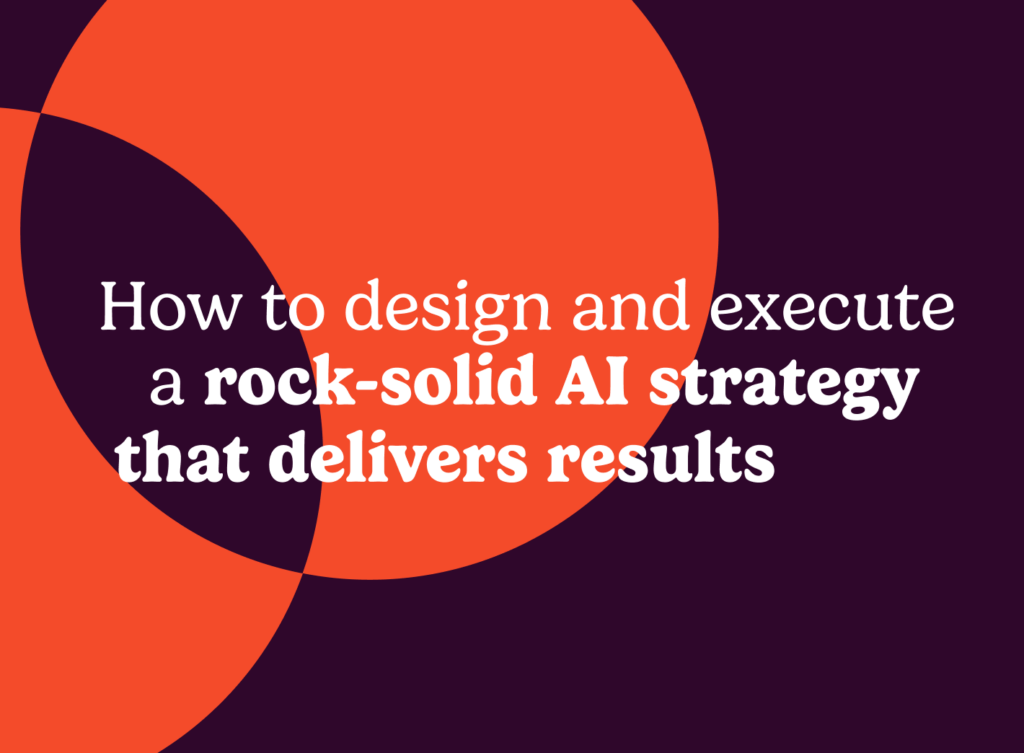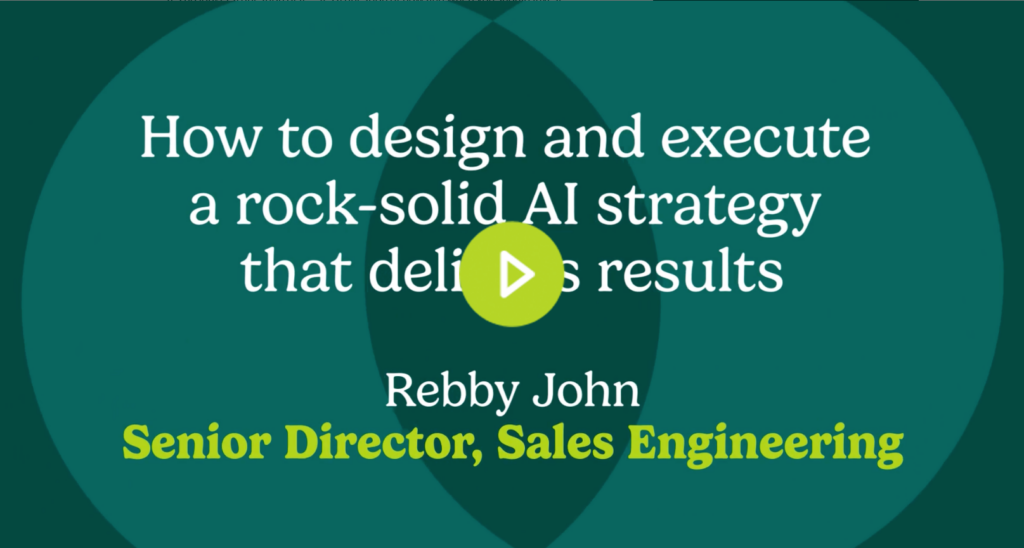Artificial intelligence (AI) has become a hot topic in recent years, dominating discussions at keynotes, executive meetings, and industry events. It’s no longer a buzzword relegated to niche corners of the tech world.
Instead, it’s a pervasive force that’s shaping the strategies of companies worldwide. In fact, 95% of executives report their organization is currently using AI in sales in some capacity, and 84% say their company has used generative AI in sales in the past year.
In this article, we’ll cover these critical topics:
- The inflection point for go-to-market teams
- A 3-part approach to thinking about AI
- What accounts should you focus on and why?
- AI case study: Salesloft Rhythm and the power of explainability
- What should you say to these accounts?
- How can these conversations help you hit your revenue and forecasting goals?
- Considerations for your AI strategy
Rather see the talk instead? Watch the on-demand video, presented by Rebby John, Salesloft’s Senior Director of Sales Engineering.
The AI revolution
A few years ago, if you asked companies about their involvement in AI-related projects, you’d likely receive limited responses. Fast forward to the present, and a significant number of organizations have ventured into AI initiatives.
What catalyzed this dramatic shift? The answer can be traced back to the emergence of powerful AI tools, with one of the most prominent being generative AI.
Generative AI, or GPT (Generative Pre-trained Transformer), burst onto the scene, democratizing the use of AI by placing the power of generative AI directly into the hands of end-users. This opened the floodgates for companies to witness firsthand the capabilities of AI and its growth over the past few years.
The inflection point for go-to-market teams
Today, AI has moved to the forefront of many companies’ strategic plans. It’s no longer a question of if, but how and when to invest in AI and machine learning.
This shift has led to a clear division between companies.
There are those who are embracing AI early and wisely, leveraging its capabilities to gain a competitive edge. And there are others who will either neglect AI investments or make misguided and inefficient choices.
We’re here to help you fall into the first category by exploring how AI can revolutionize your go-to-market strategy.
A 3-part approach to thinking about AI
Before we talk about the use cases for AI, let’s talk about the approach.
As sales and marketing professionals, especially those in operations, you know that you aren’t in the business of throwing things at the wall and hoping they stick. You often start with a problem or a question.
So as we go through this blog, we’re going to look through the lens of three different questions:
- What accounts should you focus on, and why?
- What should you say to these accounts?
- How can these conversations help you hit your revenue goals?
These three questions serve as the foundation for go-to-market. And to navigate these questions effectively, we’ll adopt a crawl-walk-run approach.
- Crawl: How you answer these questions manually
- Walk: GTM operations has lived in this space for a long time, and involves strategy around automation and integration for example
- Run: How we leverage AI to answer these critical business questions
Core question #1: What accounts should you focus on and why?
The basic concept here is not new — it’s all about prioritization. In the context of today’s environment, GTM teams are always talking about priorities.
But what should you chase first when everything is important?
Nowhere is this truer than in sales and marketing. At any given time, there are so many accounts to go after, so many activities to do on a day-to-day basis, so many data sources that are all giving you competing information.
Yet the buying window for any given account is relatively small.
If you’ve bought software before or you’re involved in the procurement process, you understand that you’re only in that window for a short time, or where it’s realistic for you to make the deal happen.
You need to make sure that your reps are hitting that window above all the other priorities that they face. Which of the following approaches best describes how your sales reps are addressing this challenge?
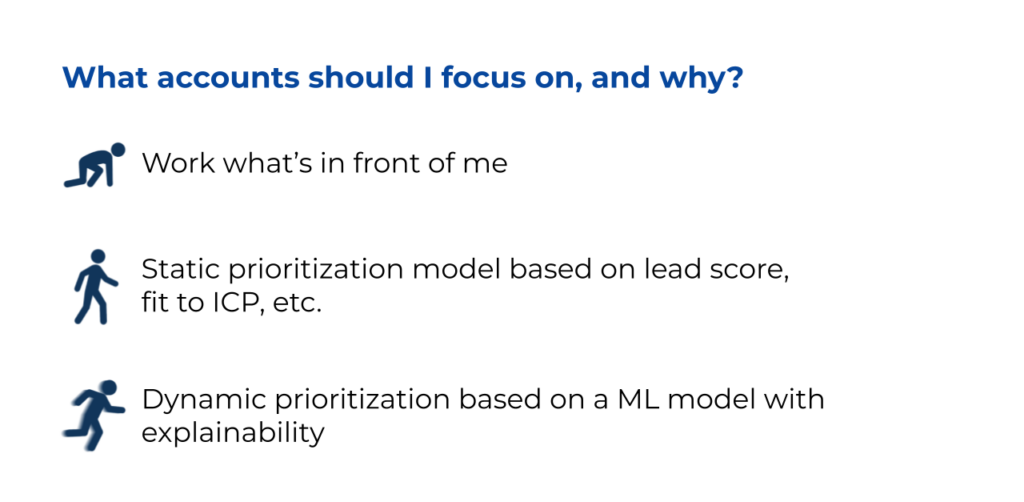
Crawl
Picture an overwhelmed sales rep at your company, a B-level performer on a quarter-to-quarter basis.
Their day might look something like this: They wake up, go through their morning routine, open up the laptop, and they get positively blasted with information:
- 52 unread emails
- Slack messages from their manager asking for an update on a deal
- A web chat tool dinging that there’s someone they need to engage on the website
- Intent data that’s telling them that they need to focus on a specific account
What do they do? Ingest all of this information and make a list?
For the majority of reps in the middle, these reps are not prioritizing their tasks each day — they’re working whatever is right in front of them and they’re using their favorite apps. And really, who can blame them?
Walk
Many companies in this phase use static prioritization models based on things like lead scores, fit to ideal customer profiles, and other criteria.
A very common use case for this approach is marketing automation. Let’s say that your company decided that manufacturing is the industry you want to target for the next 3-6 months. Companies in the “walk” stage might follow a framework like this:
- You decide to build a contact form on the website to collect leads
- You’ve set up automation to assign the relevant leads to a rep and a cadence
- And your rep takes action based on the cadence steps you’ve defined (e.g. email, call, social)
This kind of automation, while static, provides a significant improvement over the manual process.
But it still has limitations. For example, what happens when the market shifts? What happens when manufacturing is no longer the important industry? What happens when the outbound engine is what you need to focus on?
You have to change the underlying model to make these constant manual adjustments, and that change takes time. It steals time away from the 21 selling days you get each month — and it’s incredibly prone to user error.
Run
This is where AI comes into play. AI can offer a dynamic prioritization model that continually learns from historical data, adapts to market changes, and provides real-time recommendations.
To ensure your sales representatives are focusing on accounts in the right buying window, AI can be a game-changer. But all those advantages are useless without one key thing: explainability.
AI conversations have exploded in recent months, and it has a long way to go to build up trust from the people who use it.
If you’re going to ask a sales rep, whose livelihood depends on what they do for those 21 selling they get each month, to blindly trust what the AI model says they should focus on for today — without any kind of explainability — you are going to get zero adoption.
And we know that adoption is ROI. So always, whether you build or buy, ensure that you have explainability built into any AI model that you think about bringing on.
AI case study: Salesloft Rhythm and the power of explainability
Salesloft Rhythm analyzes buyer behaviors and prioritizes the most critical actions for revenue teams.
This gives sellers, specifically AEs, the ability to work from a single pane of glass instead of switching from app to app — and it gives them one priority to focus on for the day.
If you have 100 opportunities in the works, for example, Salesloft Rhythm would show you the one opportunity you should focus on right now, and why, without relying on guesswork.
Salesloft Rhythm makes every sales action meaningful, but most importantly, it has that explainability built in for the people using it.
We knew early on in the product roadmap that we would need to answer the question: “What is the AI doing here, and why should I trust it?”
When sales professionals understand how AI algorithms arrive at their recommendations or predictions, they are more likely to have confidence in the technology and, consequently, they are more likely to use it. Sales tools that “show their work” will empower organizations to leverage ethical AI.
In the example below, Salesloft’s AI looks at criteria such as stakeholder engagement to provide a “Deal Engagement Score” so sellers and managers can quickly assess the strength of a deal based on various factors, including stakeholder engagement. For this reason, sellers know exactly why the AI identified the action. This drives adoption in the AI model.
Core question #2: What should you say to these accounts?
Crafting compelling messaging is a fundamental aspect of your go-to-market strategy, so let’s get into the different approaches for how you communicate with your accounts.
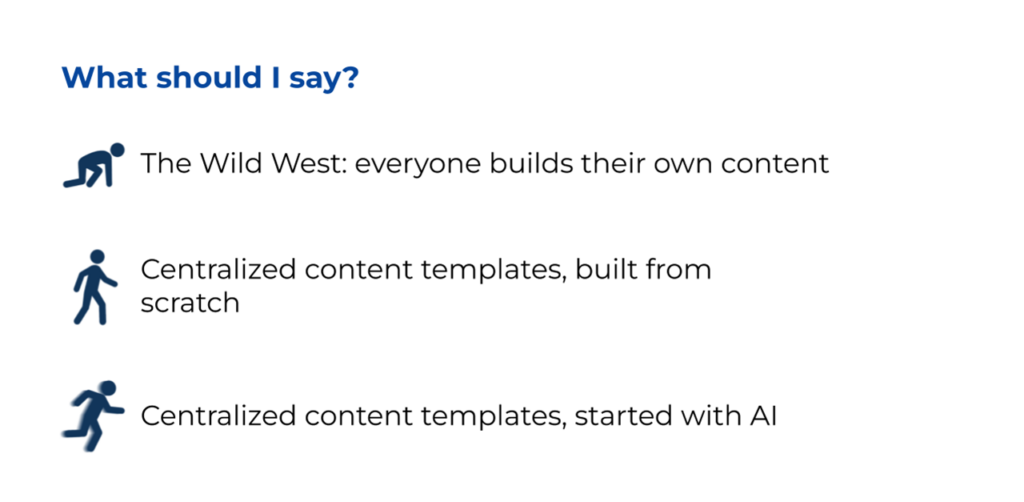
Crawl
If you’ve ever been a part of a startup, you’ll recognize this phase. It’s the Wild Wild West. Everyone builds their own content.
And we all know how this movie ends: it’s a surefire recipe for 100 different email templates and 100 different Google docs, 50 kids of social media posts — none of which follow your branding teams follow your best practices and guidelines.
It’s just not scalable.
Walk
The walk approaches typically involves centralized content templates that are built from scratch. This is the purpose of marketing automation. It’s one-to-many, structured messaging that goes out to your account base, with perhaps some light personalization based on mail merge fields and such.
In fact, the sales engagement industry has its origins in this exact approach.
But if you’ve ever been in a role where producing content was a part of the job (e.g. SDR email templates), you know how difficult it can be to start from scratch. You often sit in front of a blank document, suffer from writer’s block, and watch the blinking cursor until inspiration strikes.
Run
On the other hand, AI and GPT functionality can generate starting points for centralized content templates for your GTM strategy.
But there are so many pitfalls here. It’s important to remember that AI-generated text is a starting point, not the final product.
Human involvement is essential to refine and tailor the content to align with your brand’s voice, context, and purpose. You won’t get starting results by simply throwing in your prompts and immediately start using it.
So what does an effective AI prompt framework look like?
Think about what you’re asking a generative AI model to do. It’s been trained on an enormous subset of data, and you’re asking it to crave off a miniscule portion of that subset of data that’s relevant to what you’re asking it. You won’t get great results if you don’t supply it with the appropriate amount of context in your prompts.
When you begin to use GPT to start your content strategy, use a clear structure to get the right subset of data from the AI model.
Let’s assume we need to draft an email as part of our post-event marketing strategy. Here’s an example of how you might structure the prompt inside of your preferred AI tool, using precise context:
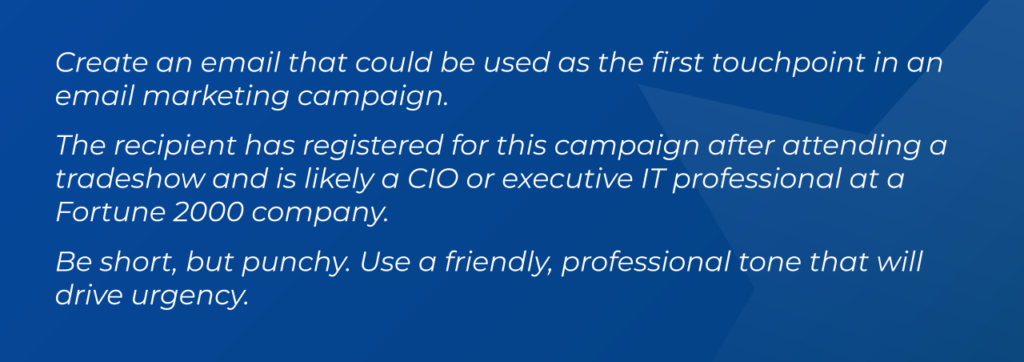
The recipe is simple:
- Start with a clear, unambiguous goal. In the example above, we know we want to draft an email as part of a wider campaign.
- Give plenty of context. Before that email can be written, we need to feed key points into the prompts: it’s a first touchpoint; the audience is executives; the preceding buyer activity was a tradeshow.
- Consider the tone of voice for the output. How does your brand speak to this particular personality or role? Should the content be short or long for the channel?
Of course, on top of this recipe, you’ll add the keywords and call-to-actions that are unique to your product or solution.
AI that leaves room for human perception
AI is powerful, but it’s not human. That’s why Salesloft’s templates and cadences essentially “start” with AI and offer plenty of room for detailed, contextual prompts that tap into a seller’s unique instincts, personality, and skillset.
Our buttons actually say, “Start with AI” and “Generate AI Draft.”
Sellers are generating AI drafts, not necessarily a finished product. The seller is in full control of their process. In the example below, you can see that the seller is able to customize the output of the generative AI draft.
Core question #3: How can these conversations help you hit your revenue goals (a.k.a. “What’s the forecast”)?
Forecasting is a critical responsibility for any go-to-market team. A consistent, accurate forecast serves as the foundation for a strong financial model that projects the growth of a company over the next fiscal quarter or year. By the same token, an inaccurate forecast can cripple a business.
This is a touchy subject for many GTM teams because there are many different ways to arrive at a forecast. These methodologies are typically honed and trained for years over sales careers.
It’s absolutely a blend of both art and science. There’s a level of human experience that comes with looking at hundreds and thousands of deals over the course of someone’s career — especially in a given industry — that AI simply cannot replicate.
So when you think about AI in your forecasting approach, you don’t want to rip and replace the art of forecasting. Instead, use it to provide a more data-driven answer to the science.
Let’s get into the crawl-walk-run approaches for reaching your forecast.
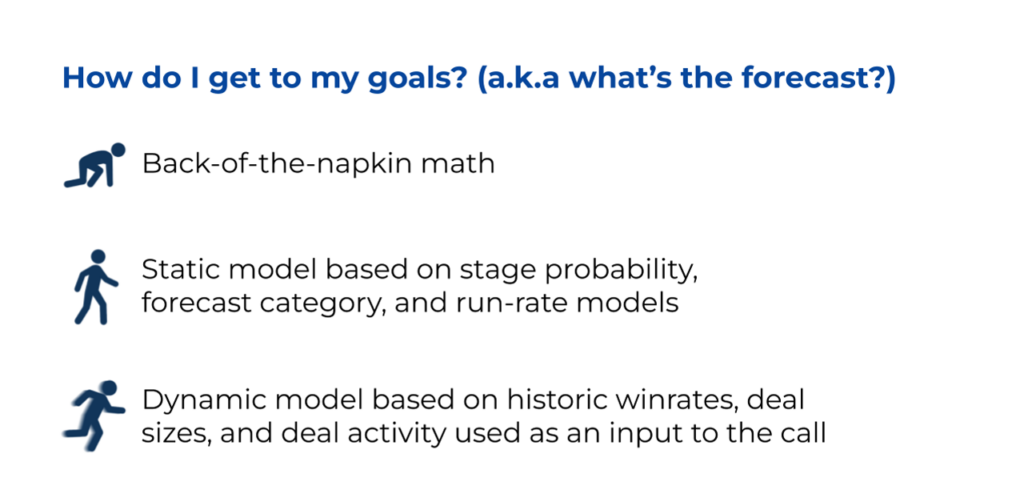
Crawl
This approach involves back of the napkin math that’s put into an Excel sheet or a Google sheet, or even literally on a physical sheet.
There are so many problems with this approach:
- Inherent assumptions
- Non-standardized methodology across different leaders
- Lack of explainability
But the biggest issue is that you’re relying on a static model that’s immediately out of date.
Walk
In this approach, you’re likely starting to use your CRM’s forecasting abilities.
You have a static model based on stage probablity, forecast category, and maybe even a run rate model for deals that you plan to create and close within the quarter. And if you’re really fancy, your run rate model will account for EOQ and EOY magic.
Run
The run approach uses AI to generate a forecast number based on historic win rates, deal sizes, and the level of activity that you’re seeing on individual deals in your pipeline. It predicts and makes a recommendation as to where you might land for the quarter or year.
The AI forecast, again, should be used as a recommendation or an input into your final number. It does not replace the art, but it can provide a better way to do the science of forecasting.
The run approach should force intellectual honesty. If your AI forecast and your gut instincts are drastically different numbers, you need to go back and review those key deals that are going to make or break your quarter or year.
This delicate balance comes to life inside the Salesloft platform, where sales and marketing leaders can leverage our AI Forecast tool to discover what their forecast could look like.
AI Forecast presents a data-driven, suggested metric that can be used to determine accurate revenue forecasts for the current quarter by using factors such as deal size, deal stage, the number of days the deal has been opened, and other factors.
Considerations for your AI strategy
Throughout this journey, it’s crucial to recognize that AI is a tool, not a replacement for your team’s expertise and experience. It’s there to enhance your data-driven approach, provide insights, and boost your go-to-market strategy’s effectiveness.
By addressing the three critical business questions above, you can hopefully move from a crawl or walk approach to harness the power of AI to stay competitive and agile in today’s dynamic market.
As the tech landscape evolves, new possibilities and strategies will emerge. What’s relevant today may change in the coming months.
Nevertheless, the fundamental approach remains the same: leverage AI as a powerful tool to enhance your go-to-market strategy and stay ahead in a rapidly evolving business environment.
Embrace it wisely, adapt to new opportunities, and ensure that your company falls into the category of early and effective AI adoption.
Recommended for you:


